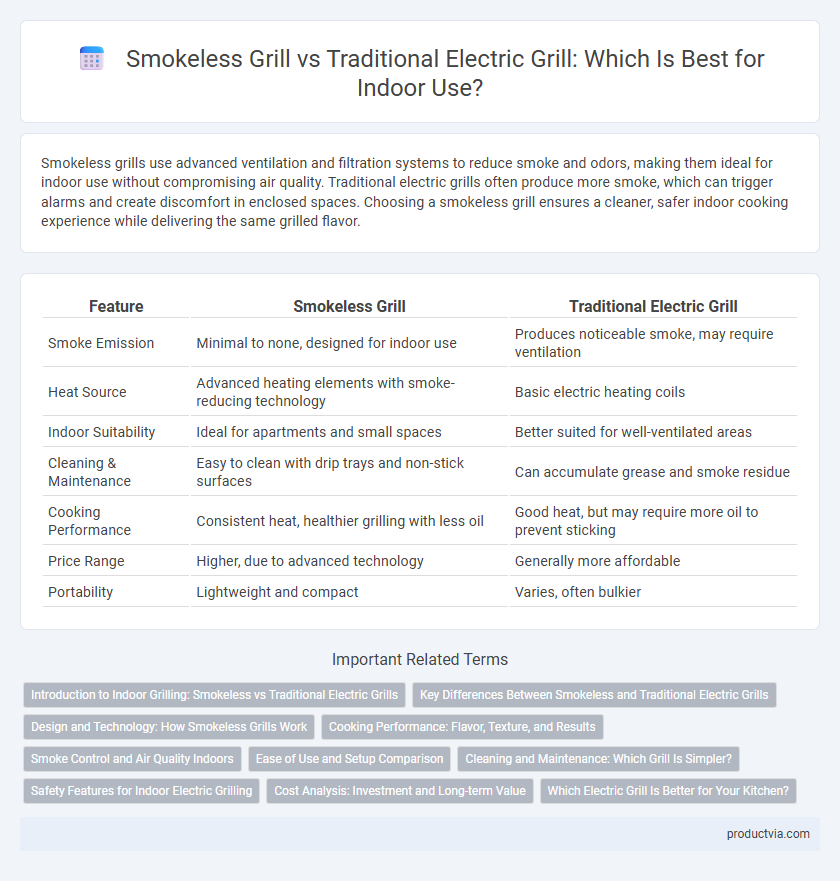Smokeless grills use advanced ventilation and filtration systems to reduce smoke and odors, making them ideal for indoor use without compromising air quality. Traditional electric grills often produce more smoke, which can trigger alarms and create discomfort in enclosed spaces. Choosing a smokeless grill ensures a cleaner, safer indoor cooking experience while delivering the same grilled flavor.
Table of Comparison
| Feature | Smokeless Grill | Traditional Electric Grill |
|---|---|---|
| Smoke Emission | Minimal to none, designed for indoor use | Produces noticeable smoke, may require ventilation |
| Heat Source | Advanced heating elements with smoke-reducing technology | Basic electric heating coils |
| Indoor Suitability | Ideal for apartments and small spaces | Better suited for well-ventilated areas |
| Cleaning & Maintenance | Easy to clean with drip trays and non-stick surfaces | Can accumulate grease and smoke residue |
| Cooking Performance | Consistent heat, healthier grilling with less oil | Good heat, but may require more oil to prevent sticking |
| Price Range | Higher, due to advanced technology | Generally more affordable |
| Portability | Lightweight and compact | Varies, often bulkier |
Introduction to Indoor Grilling: Smokeless vs Traditional Electric Grills
Indoor grilling offers a convenient way to enjoy grilled flavors year-round, with smokeless grills reducing smoke emissions through advanced ventilation technology, making them ideal for apartments and small spaces. Traditional electric grills operate by heating metal plates, often producing smoke from food drippings, which may require additional ventilation. Choosing between smokeless and traditional electric grills depends on factors such as cooking style, smoke sensitivity, and indoor air quality preferences.
Key Differences Between Smokeless and Traditional Electric Grills
Smokeless grills utilize advanced infrared or charcoal heating technology combined with enhanced ventilation systems to significantly reduce smoke production compared to traditional electric grills, which rely on exposed heating elements that often generate more smoke and odors. Smokeless grills typically feature non-stick, drip trays, and sealed designs that capture grease and prevent flare-ups, whereas traditional electric grills may lack these innovations, resulting in more smoke and uneven cooking. Furthermore, smokeless grills offer more consistent temperature control and faster heating times, making them ideal for indoor use where smoke and ventilation are concerns.
Design and Technology: How Smokeless Grills Work
Smokeless grills utilize advanced infrared heating technology and efficient ventilation systems to reduce smoke production, making them ideal for indoor use. Their compact design incorporates features such as non-stick surfaces and built-in smoke filters, enhancing easy cleanup and maintaining air quality. Traditional electric grills rely on standard heating elements without specialized smoke reduction, often producing more smoke and requiring additional ventilation.
Cooking Performance: Flavor, Texture, and Results
Smokeless grills utilize advanced ventilation and heating technology to reduce smoke while preserving intense, char-grilled flavor and tender texture, unlike traditional electric grills which may produce more smoke but often result in uneven cooking and drier outcomes. The even heat distribution in smokeless grills ensures consistent searing and caramelization, enhancing flavor depth and juicy, tender results. Traditional electric grills tend to have hotspots that can cause overcooking or undercooking, compromising both texture and overall flavor quality in indoor cooking scenarios.
Smoke Control and Air Quality Indoors
Smokeless electric grills utilize advanced ventilation and grease management systems to significantly reduce smoke emissions, improving indoor air quality by minimizing airborne particles and odors. Traditional electric grills often produce more smoke due to less efficient heat distribution and fat vaporization, which can trigger indoor air pollution and require additional ventilation. Choosing a smokeless grill enhances smoke control, making it a healthier option for indoor cooking environments.
Ease of Use and Setup Comparison
Smokeless grills feature advanced air circulation and filtration systems that minimize smoke production, making setup simpler and more convenient for indoor use compared to traditional electric grills, which often require additional ventilation. The easy-to-clean drip trays and nonstick surfaces on smokeless grills reduce preparation and maintenance time. Traditional models may demand more space and effort to assemble, while smokeless grills typically offer compact designs with intuitive controls for quick startup.
Cleaning and Maintenance: Which Grill Is Simpler?
Smokeless grills typically feature non-stick surfaces and detachable drip trays, making cleaning faster and more efficient compared to traditional electric grills, which often accumulate grease in hard-to-reach areas. The absence of excessive smoke in smokeless grills means less residue buildup, reducing the frequency and intensity of maintenance. For indoor use, users find smokeless grills simpler to maintain due to their design that minimizes oil splatter and promotes easy disassembly.
Safety Features for Indoor Electric Grilling
Smokeless grills utilize advanced ventilation and filtration systems to significantly reduce smoke emissions, enhancing indoor air quality and minimizing fire hazards compared to traditional electric grills. Safety features such as automatic shut-off, temperature control, and cool-touch exteriors are commonly integrated into smokeless models to prevent overheating and accidental burns. Traditional electric grills often lack these comprehensive safety mechanisms, making smokeless grills a safer choice for indoor electric grilling environments.
Cost Analysis: Investment and Long-term Value
Smokeless grills typically require a higher initial investment, averaging $150 to $300, compared to traditional electric grills, which often range from $50 to $150. The advanced filtration technology in smokeless grills reduces smoke and odor, potentially lowering cleaning and maintenance costs over time, enhancing long-term value. Traditional electric grills may incur higher long-term expenses due to frequent replacement of drip trays and increased ventilation requirements.
Which Electric Grill Is Better for Your Kitchen?
Smokeless grills utilize advanced infrared technology and superior ventilation systems to reduce smoke production by up to 90%, making them ideal for indoor use without triggering smoke alarms. Traditional electric grills often produce more smoke due to open heating elements and less efficient grease management, which may not be suitable for small kitchens or apartments. For a healthier, cleaner kitchen environment, a smokeless electric grill offers better usability and convenience than conventional electric grills.
Smokeless grill vs Traditional electric grill for indoor use Infographic

 productvia.com
productvia.com